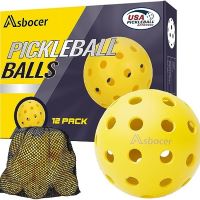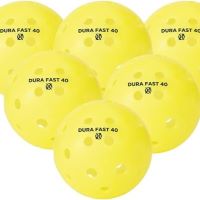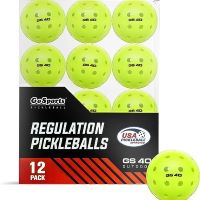Have you ever wondered what is a pickleball ball made of? It’s not your average tennis ball. It is made out of entirely different materials. Whether you’re a seasoned pickleball player or just starting to dip your toes into the sport, understanding the construction of this little ball can enhance your game and enjoyment on the court.
We are going to discuss what is a pickleball made of, the materials used for making pickleball, etc. So grab your paddles, and let’s get started!
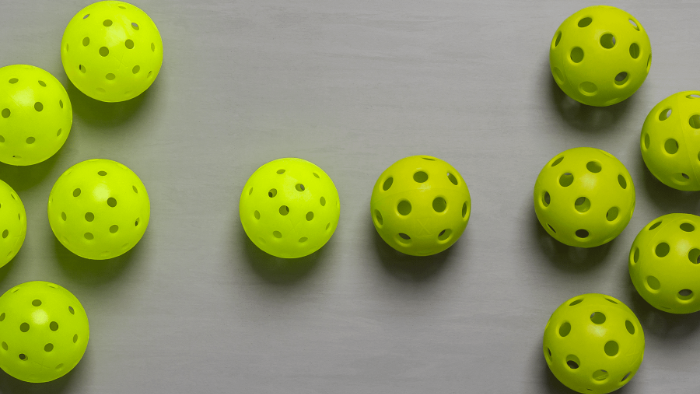
You Might Also Like:
What Is a Pickleball Made Of?
Pickleball is a sport that combines tennis and ping pong elements. The game is played with a round, hard rubber ball smaller than a tennis ball. Its goal is to get the ball into your opponent’s court by passing it over the net.
Natural rubbers and celluloid acetate are used to make pickleball balls. A synthetic material called celluloid acetate was once employed as a stock for motion picture films. It can be heated to mold it into spheres or discs because it has an extremely low melting point. Pickleball balls are made to bounce higher by using natural rubbers.
A standard pickleball ball measures 2.87 inches (7.29 cm) in diameter, slightly less than a tennis ball. A pickleball ball weighs between 0.78 and 0.935 ounces (22 to 26.5 grams). Pickleball balls are available in any color, but the most popular variety is yellow, with tiny holes all over. The ball’s aerodynamics, which impacts its flight and bounce, depends on the holes.
It’s worth noting that there are also indoor and outdoor versions of pickleball balls, as the playing surfaces and conditions differ. Indoor balls are typically lighter and have smaller holes to compensate for the smoother indoor playing surface. In comparison, outdoor balls are heavier and have larger holes to counter wind resistance.
Overall, a pickleball ball’s structure is essential to the performance and competitiveness of the sport. Thus, producers must ensure their products adhere to the rules established by the sport’s governing bodies.
What Materials Are Used for Making Pickleballs?
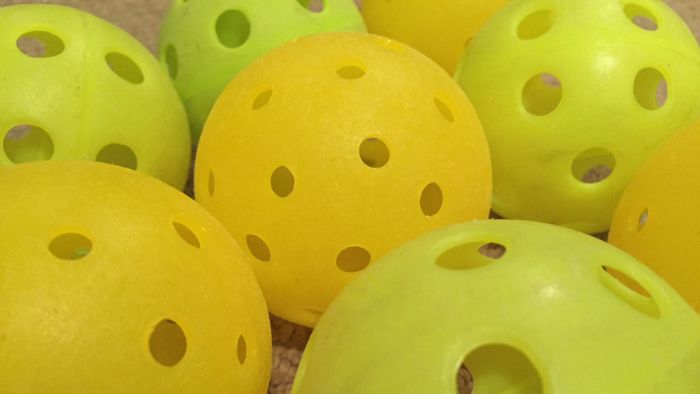
The traditional sport of pickleball, developed in the 1970s, uses a celluloid or plastic ball with a rubber bladder. Pickleball balls come in indoor and outdoor varieties. The outdoor ball, made for playing on hard surfaces, is smoother and lighter than the indoor ball.
The most common materials used to make pickleballs are celluloid or plastic, rubber, and metal. Celluloid is a type of plastic that is soft and pliable. It is the most common material used to make pickleballs because it is affordable and durable. Plastic is another common material used to make pickleballs because it is cheap and durable.
Rubber is a soft, stretchy material often used in products designed to be bouncy or elastic. It helps to make the ball bounce more easily and prevents it from becoming damaged when it hits the ground. Pickleballs are frequently made of metal since it is durable and has a flat surface. Metal is less frequently utilized because it is heavier and less springy than other pickleball-specific materials.
A pickleball can also be made by combining several materials, such as rubber and plastic, to provide a durable ball with good bounce. More environmentally friendly pickleball materials, like recycled plastics or biodegradable materials, have become popular in recent years. Ultimately, the choice of materials to manufacture pickleball balls depends on factors such as cost, durability, bounce, and environmental impact.
What Are Indoor Pickleballs Made Of?
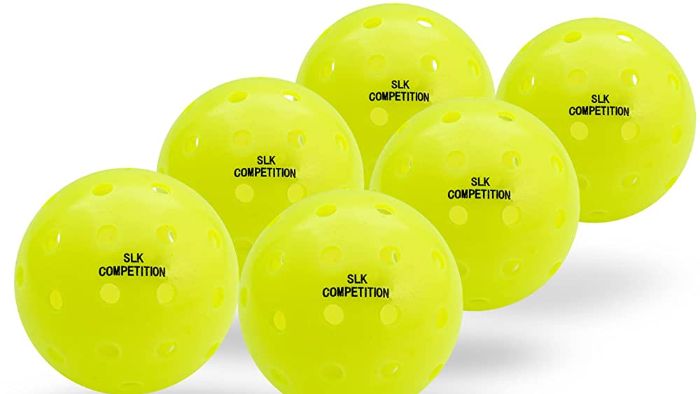
The indoor pickleballs are made of polyurethane and are roughly the size of a softball. The fact is that they come in various colors and frequently have ridges on the outside affects how they bounce compared to regular balls. The low bounce of indoor pickleballs makes them ideal for playing on smooth indoor surfaces like gym floors or indoor courts.
These balls comprise a durable polyurethane material that can resist damage from repeated use. The outer ridges of the ball contribute to a unique bounce pattern, increasing the challenge and complexity of the indoor pickleball game. The distinct colors of indoor pickleballs also help players recognize balls from different games or teams, making it easier to follow the action on the court.
In general, indoor pickleballs are an essential part of the game and were developed with indoor play in mind. They are excellent for those who like to play pickleball in a supervised indoor environment.
What Are Outdoor Pickleballs Made Of?
PVC is the most common material used to make outdoor pickleballs, but it can also be made of rubber. A harder latex or rubber layer is placed on top of a softer latex or rubber core to create the pickleball ball. This combination produces perfect symmetry between speed and bounce.
The ball will swiftly rebound off the surface after colliding with an object and continue to roll. Some outdoor pickleballs are constructed of a blend of polymers like polypropylene in addition to PVC and rubber. These materials are perfect for outdoor play because they are strong and resistant to the elements. The diameter and weight of the ball must fall within the prescribed ranges of 2.87 and 2.97 inches and 0.78 and 0.935 ounces, respectively.
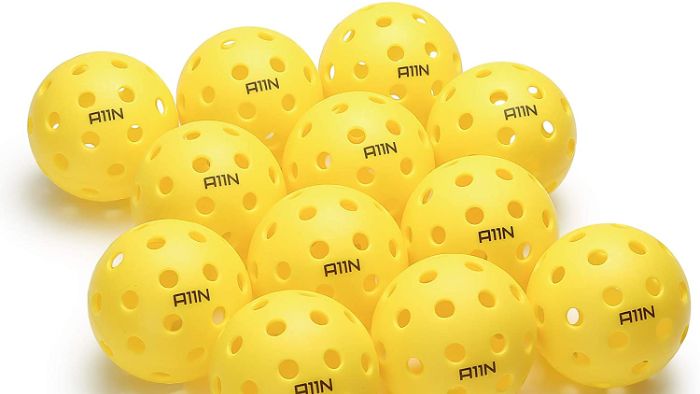
Like Wiffle balls, pickleballs are similarly made with tiny holes on their surface. These holes assist in reducing the speed of the ball and improving game control. Outdoor Pickleballs are crafted to endure various weather conditions, such as heat, wind, and rain, while maintaining their shape and quality.
Frequently Asked Questions
The diameter of a pickleball must be between 2.87 and 2.97 inches.
Weight restrictions for pickleball balls range from 0.78 to 0.935 ounces.
Pickleball balls have perforations on their exterior that aid in slowing them down and increase control during play.
The answer is yes; pickleball balls can survive heat, rain, and wind without losing their shape or quality.
Outdoor pickleballs come in various colors and can be made to fit any theme or setting.
Yes, various pickleball ball types are made for indoor and outdoor play and different playing levels.
There are typically 26 holes in a pickleball ball. The holes are evenly distributed on the ball’s surface and are designed to reduce its speed and provide more control during play. The holes are also responsible for the signature “whiffle” sound that pickleballs make when they are hit.
Polypropylene, a tough plastic frequently used in packaging, textiles, and stationery, is the substance used to make pickleballs. To reduce wind resistance and give the ball the desired flight characteristics, the plastic is molded into a sphere with tiny holes on the surface. Pickleball is additionally available in an array of colors, such as yellow, green, and orange, to enhance player visibility on the court.
Conclusion
Pickleball is a game that demands extensive coordination and strategic thinking, as affirmed by those who have experienced it. The crucial element to emerge victorious is to observe your opponent’s actions and anticipate their upcoming maneuvers. A successful pickleball game requires the right pickleball, essential for enabling the sport.
Understanding regarding the materials that the company that makes pickleball balls utilizes to make those balls is essential. Generally speaking, rubber, metal, and plastic make up pickleball balls. Reading this blog will help you better understand about what is a pickleball ball made of, the materials used for making pickleballs, etc.

